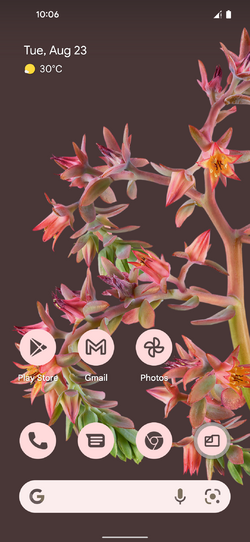Build list legend
Non-existent page
| Version of Android | |
 | |
| Version | 12.0 |
|---|---|
| Codename | Snow Cone |
| Preliminary name | Android S |
| Latest build | |
| Release date | 2021-10-04 |
| Support end | |
Android 12 is a version of Google's Android OS, which was released on 4 October 2021 to AOSP and actively supported Google Pixel devices. With many other OEMs like Samsung following suit in porting to the new major release.
The platform was supported continuously with monthly releases and Quarterly Platform Releases (QPRs), with Android 12 QPR1, Android 12L, and Android 12 QPR3 being released. Android 12 is still receiving security bulletin backport coverage and will so for the incoming months, despite not having any more active development work and new quarterly/monthly releases being shipped.
Android 12 introduced a new version of Google's Material design system called Material 3 (announced under the name Material You and codenamed Silk during development). According to Google, this version seeks to create designs that are personal, adaptive for every screen, accessible and feel alive.[1]
A headlining feature of Material 3 is a feature, codenamed Monet, which extracts primary and accent colors from the wallpaper. Those colors can then be used across apps. Notably, in previous versions of Material Design, each app defined its own color palette.
When Android 12 first released, the algorithm powering color extraction wasn't present in the public source code. The source code for it was later released as part of the Android 12L source code.
To make using large phones more comfortable, title bars in many apps can be expanded. This feature was first uncovered in the first developer preview build via a flag in the Settings app, but would later come to many system apps in beta builds.
Many animations, including the unlock and tap animations, were updated. Additionally, a new overscroll animation was added, where, if something was scrolled past the end or the start, it would stretch to indicate that there is no more content.
Widgets now have rounded corners which can be controlled by the device's OEM. Additionally, support for editing widgets was added.
Every app now launches with a splash screen. Apps can also customize it.
Although transparency and blur effects can rarely be seen in Material 3, Android 12 made it easier for developers to blur the background or other parts of their apps.
This is another area that received major improvements.
A setting was added that showed important privacy and security related information, such as the security patch level and how often apps access dangerous permissions like the camera or location.
When an app accessed the camera or microphone, an indicator was shown in the status bar.
Toggles were added to the quick settings menu that could be used to disable camera and microphone access to all apps.
When an app requested access to the user's location, Android 12 allowed them to choose between sharing their precise location or a general location. Previous versions of Android only gave a choice between allowing or denying access.
When taking a screenshot, a "Capture more" button could be seen, which allowed users to take a screenshot that had more content than what was shown on the screen.
This feature was already available in variants of Android developed by many OEMs.
When playing a game downloaded from Google Play, a new icon could be seen that opened a panel with extra settings. It has options to record the screen, see the frame rate, stream to YouTube and take a screenshot. A new Game Mode Interventions API allowed OEMs to improve the performance of games that are no longer being updated by developers.
An API was added that apps could use to make their content searchable and to search across apps.
Official support for under-screen fingerprint readers was added. Google's Pixel 6 series of phones, released in the same year as Android 12, featured under-screen fingerprint readers.
For a more complete list of tagged, stable releases of the Android Open Source Project & the Android 12 platform, see Codenames, tags and build numbers.
Build list legend